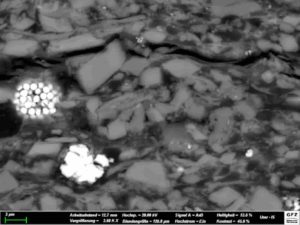
The Alum Shale of Northern Europe not only has an eventful history of formation, connected with the microcontinent Baltica, it also holds great potential as an object of investigation for future research questions. Geologists use the rock to reconstruct processes of oil and gas formation, and even possible traces of past life on Mars can be identified with its help. Researchers at the German Research Centre for Geosciences Potsdam GFZ, together with colleagues from Canada, China, Switzerland and Denmark, have summarized the state of knowledge about the multi-layered rock. Their article was published in July in the journal Earth-Science Reviews.
The microcontinent ‘Baltica’
“This rock tells a story,” says Hans-Martin Schulz when he talks about the Northern European Alum Shale. It is the checkered history of a microcontinent called “Baltica”, which was located in the southern hemisphere about 500 million years ago. “The microcontinent is surrounded by a calm, shallow marginal sea,” says the scientist in the GFZ’s Organic Geochemistry Section, describing the situation in the period from the Middle Cambrian to the Lower Ordovician. Higher land plants do not yet exist, and the surface of Baltica is exposed to wind and weather. “Rocks weather, and debris and dust are carried into the sea. Together with components of algae and other microorganisms, they trickle through the layers of the calm marginal sea and settle layer by layer in the oxygen-free bottom water,” Schulz continues. These organic-mineral deposits fossilize and form the dark claystone that makes up today’s Alum Shale. Over millions of years, Baltica migrated northwards and is now integrated into northern Europe. “Almost half a billion years later, the Baltic Sea forms on Baltica,” Schulz concludes the first part of the story.
Oil and gas formation in phases
For three years, Schulz’s group and international colleagues have been combing through their own data and that of other research groups. In their comprehensive synopsis, they also describe the different phases of oil and gas formation during Baltica’s development. Parts of the microcontinent sink to depths of several thousand meters during migration. Oil forms under the influence of geothermal heat. “The oil that was generated at that time is now produced on the Swedish island of Gotland and in the Baltic Sea off the Polish coast,” Schulz explains.
Other parts of the microcontinent occur more near the surface, for example in what is now southern Sweden. There, about 300 million years ago, increased expansion of the earth’s crust takes place. Magma escapes, the heat of which causes further crude oil to form in the Alum Shale. “These rather regional deposits are enclosed in the rock,” the geologist describes. At the end of the last ice age, about ten thousand years ago, sweet meltwater penetrates the shale here. “It meets tiny inclusions of ancient seawater. They contain bacteria that have survived for millions of years,” Schulz describes. The fresh water awakens them to new activity, and further bacteria are possibly contained in the meltwater. The microbes decompose components of the oil and form methane gas.
Influence of uranium
And that’s not the end of the story: although there is still plenty of organic material, the oil-forming potential of the Alum Shale is declining. This is because it contains uranium, whose radiation alters the enclosed carbon compounds over long periods of time—”with fatal consequences for oil formation”, as Schulz says. “The long chains are split off,” he explains. “What remains are ring-shaped hydrocarbons, predominantly benzene rings, which are linked together.” These changes prevent the further formation of petroleum from the organic remnants of Cambrian and Ordovician life. The uranium probably originated in the rocks that were eroded on Baltica and settled in the sea. “And seawater also contains dissolved uranium, so some of the radioactive metal could have been absorbed by the sediments from it,” Schulz adds.
Alum shale has many talents
The GFZ researcher and his team are investigating the significance of the very high uranium concentrations in places in the Alum Shale: “Can organic material altered by uranium still feed a deep biosphere?” they are asking themselves in ongoing studies, for example. Or does the radioactive fission of hydrocarbons prevent microbes from surviving at great depths? And it is not only the influence of uranium on microbial life that interests him. “The Alum Shale is a rock with many talents,” Schulz says. “We can study numerous processes on it at different depths, at different degrees of maturity of the organic material, different uranium concentrations and sometimes extreme conditions.”
The Alum Shale may even have answers to the question of past life at a distance of 70 million kilometers from Earth: organic components have been found on Mars that have structural similarities to those found in the Alum Shale. And similar to the uranium-containing terrestrial mudstone, these molecules were exposed to the equally radioactive cosmic over long periods of time. “So these hydrocarbon compounds could be the altered remains of organisms similar to our earlier bacteria,” Schulz explains. “The Alum Shale serves as a Mars analog for us to interpret the possible traces of past life on our neighboring planet.”
Insights into final disposal of nuclear waste?
For us on Earth, another aspect of his research is topical: besides salts and granites, mudstone is a candidate for the final disposal of nuclear waste. “We also have ideas for future projects on this,” Schulz reveals. “At the core of this is the question of microbial life over long periods of time in the low-porosity, uranium-rich Alum Shale—but that story is on another page.”
Reference:
Hans-Martin Schulz et al, The Furongian to Lower Ordovician Alum Shale Formation in conventional and unconventional petroleum systems in the Baltic Basin – A review, Earth-Science Reviews (2021). DOI: 10.1016/j.earscirev.2021.103674
Note: The above post is reprinted from materials provided by Helmholtz Association of German Research Centres.










